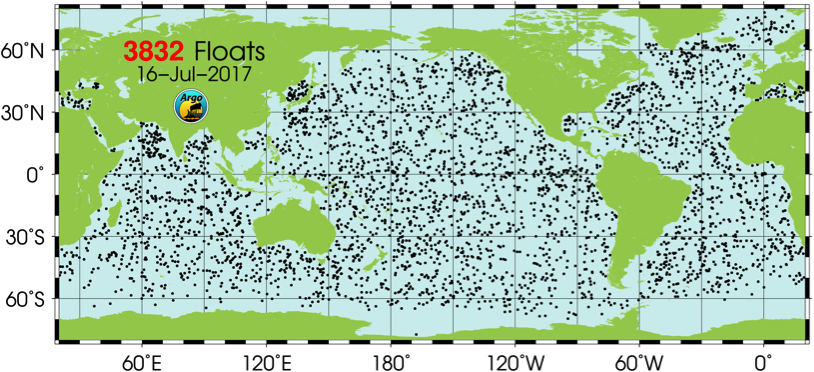by Becki Beadling
Greetings from the Pacific! Aside from my job as a CTD
watchstander, I have been recruited to help with the deployment of floats along
the course of the cruise. Before beginning to study oceanography a few years
ago, I had no clue there were thousands of “robots” roaming throughout our
oceans completely on their own. I assume many people also aren’t aware of these
ocean robots known as profiling floats. So what are these things? Right now
there are over 3,800 floats roaming our ocean, collecting data on pressure,
temperature, salinity, and relaying their observations to satellites above the
Earth.
 |
| Image courtesy of Argo (http://www.argo.ucsd.edu) |
The global ocean observing system of autonomous floats known as Argo deployed its first float in 2000. Since then, the thousands of floats deployed continue to transform our knowledge of the state of our oceans by providing real time observations of temperature, salinity, current velocities, and in some cases biogeochemical tracers including pH, nitrate, and oxygen concentrations globally. These battery powered floats spend their lifetime (~ 6 years) drifting throughout the upper 2,000 meters of the ocean. These floats begin their journey as they are dropped off the side of ships and sink to a “parking depth” of 1,000 meters where they drift throughout the ocean until a bladder inside of the float is triggered to deflate, allowing the float to sink to 2,000 meters. From this point the float’s bladder is triggered to inflate and rise to the surface over the course of six hours. Once the float reaches the surface it transmits all of its observations to satellites and the data is made publicly available usually within hours of being collected – check this out for real time data on the float locations and data collected.
 |
Image courtesy of Argo (float’s cycle). Learn more about Argo floats at http://www.argo.ucsd.edu
|
So far on our journey from Sydney to Tahiti we have deployed three out of twelve floats that we plan to add to the global observing system! On this leg we have four different types of floats that we are dropping off along the way, each designed differently with different measuring capabilities based on the sensors it has on board. Check out the pictures below from our first two deployments and the profiles already produced from our SIO-SOLO float deployed just 6 days ago!
Next float deployment in 2 days!
 |
| Isa Rosso (Co-chief scientist, UCSD Scripps Institute of Oceanography) and Jennie Mowatt (Marine Technician, Antarctic Support Contractors) deploy our first UW float built at the University of Washington. The antenna and sensors to measure temperature and salinity can be seen at the top of the float. |
 |
Jennie Mowatt (Marine Technician, Antarctic Support Contractors) and me deploying our second UW float.
|
 |
| Data collected from our SIO-SOLO float deployed on July 12th , courtesy of SIO Argo. You can keep up with this float and the data it provides here. |
You can follow my journey
here!







Comments
Post a Comment